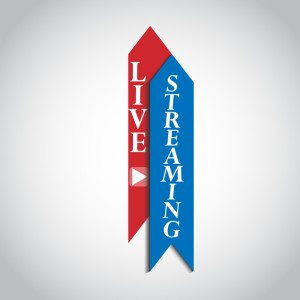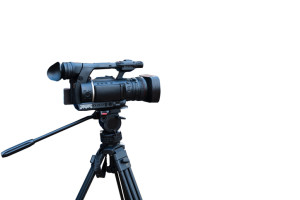Graduation Ceremonies Being Broadcast Live Online
No matter the context, a graduation ceremony is a noteworthy event. Graduation represents the culmination of years of effort, hard work, and dedication on the part of students. As such, the people involved in these students’ lives want to be part of graduation ceremonies as well. And those who know how to broadcast live online have the right tools to ensure that no one misses the big day–wherever they may be on the big day!
In the past, attending a graduation ceremony generally entailed long and arduous travel for family members, friends, and associates. In recent years, however, there have been significant advancements in technology to broadcast live online. Today, anyone with an internet connection and a connected device (e.g., smartphone, computer, tablet, smart TV) can tune in live.
The short answer to the question “should graduation ceremonies be broadcast live online?” is yes! Of course, there are a number of practical considerations for live streaming graduation or similar event. In this article, we’ll educate you on these graduation-specific considerations, as well as covering some internet streaming basics.
First, we’ll first review live streaming basics for those new to the topic. Later, we’ll cover equipment requirements to broadcast live online. We’ll also explore set-up considerations for graduation ceremonies in particular. Finally, we’ll discuss potential use cases for graduations broadcast live online.
Introduction to Live Streaming
Although internet live streaming is is technically complex behind the scenes, it is surprisingly simple for users! Essentially, if you want to broadcast live online, you need three basic components: a broadcaster, a platform, and viewers. Let’s review each in more detail below.
The Broadcaster
 The broadcaster captures the content (which is usually video but is sometimes audio-only).
The broadcaster captures the content (which is usually video but is sometimes audio-only).
To stream live video, broadcasters need a capture device that connects to the internet. Possible capture devices include a camera or just a microphone. In the case of a smartphone camera or something similar, you can complete this connection directly. However, more often than not you’ll need an encoder as well. We’ll describe encoding software and hardware in more detail below.
The Platform (Video Host or Server)
After connecting the camera and/or microphone to the internet, the video host distributes your content to servers that process the video. In turn, these servers rapidly duplicate and distribute the broadcast to multiple locations closer to where viewers are found. Choosing to broadcast live online via a dedicated, professional OVP like Dacast both streamlines the process and reduces latency and buffering.
The Viewer
For viewers, watching a video broadcast live online is as simple as clicking play.
In fact, it’s no different from watching a YouTube video—except that you might want to mark your calendar to tune in at the right time.
Internet broadcasts can also adapt to each viewer’s individual internet speed. In other words, viewers with fast internet speeds can access a high-definition stream. Those with lower internet speeds, on the other hand, can access the same content in lower-quality.
Why Broadcast Live Online?
Video over the internet is becoming more and more popular. Experts predict that by the end of this year (2019), the number of people using streaming media to meet their entertainment and news needs will more than triple to over 330 million.
 When compared to traditional broadcasting, live streaming saves money, time, and effort. That’s because live broadcasters aren’t competing for a limited set of airwaves; the internet is a much larger space. Without a limited number of channels on which to stream, live online video can expand indefinitely.
When compared to traditional broadcasting, live streaming saves money, time, and effort. That’s because live broadcasters aren’t competing for a limited set of airwaves; the internet is a much larger space. Without a limited number of channels on which to stream, live online video can expand indefinitely.
Now, let’s consider three reasons why many individuals and companies choose to broadcast live online.
1. TV in Decline
Increasingly, individuals are abandoning their television and cable subscriptions in favor of internet-based media. The proliferation of smart TVs and streaming media boxes and sticks (like the Roku) have further accelerated this process. Within the next 10 years, we’ll likely see a major decline in television. At the same time, we’ll experience a major upswing in live broadcasting over the internet.
This trend is moving especially quickly among the highly-coveted millennial generation. This generation finds navigating the internet much easier and faster to use than television. And let’s face it–traditional TV hasn’t undergone many upgrades since Tivo emerged for show recording). We can only expect this trend to accelerate in the coming years.
With this trend shaping today’s market, streaming a graduation ceremony just makes good sense. In the very near future, this will be the best way to reach your audience on their own devices and from anywhere in the world.
2. Internet-Driven Innovation
 Live streaming solutions also allow content creators more flexibility and power as compared to traditional broadcasting.
Live streaming solutions also allow content creators more flexibility and power as compared to traditional broadcasting.
For example, viewers around the world can access content broadcast live online. It’s a simple characteristic, and it’s absolutely critical. Television broadcasts released in multiple countries face extremely complex licensing and rights negotiations and contracts. Live streaming sidesteps these hurdles yet maintains the ability to, for example, use IP address blacklisting. This live streaming feature restricts viewers in certain countries or locations from viewing your content, as you see fit.
The internet also allows for two-way communication in a manner that television never could. For example, live streams can include chat, forum, and discussion features to engage the audience. Polls and questions can solicit live feedback, and users can integrate these features with minimal effort. On traditional TV, this process would be nearly impossible.
Use Cases for Streaming Live
In schools and universities, live streaming is already common with seminars, presentations, and classes. More and more, education is moving onto the internet. Graduation ceremonies and other events are a natural extension of this trend.
Another example of innovation through live streaming in a media context relates to customization features. For example, Major League Baseball’s official app allows fans to view live games. With live streaming, viewers have access to two games of their choice side by side. Likewise, the MLB can set custom scoreboard notifications. This sort of customization builds powerful user engagement and will be adopted by more and more educational institutions as the market develops.
With Dacast, too, broadcasters can package their HLS feed into an app suitable for mobile devices. This is an easy and affordable way to capture valuable users and build a more immersive experience. Increasingly, universities and other institutions of higher learning are capitalizing on the value of dedicated apps for event entry, ticket purchase, emergency notifications, on-campus navigation, and more.
In short, live video can play a key role in making these apps useful, and a graduation ceremony is no exception.
3. Saving Time and Money
Broadcast live streaming can also save time and money compared to other forms of recording and broadcast. By 2019, the price of live broadcasting is drastically lower than it has ever been. This trend is due, in large part, to the ever-rising speeds of internet connections, as well as the falling cost of high-quality audio-video equipment.
 The declining complexity of the equipment needed to broadcast live online contributes to this trend as well. In past years, live broadcasts required a satellite truck, production-grade $30,000 cameras, multiple assistants, and an entire TV station. Nowadays, anyone with a smartphone can broadcast live in about 15 seconds via an app like Periscope or Meerkat.
The declining complexity of the equipment needed to broadcast live online contributes to this trend as well. In past years, live broadcasts required a satellite truck, production-grade $30,000 cameras, multiple assistants, and an entire TV station. Nowadays, anyone with a smartphone can broadcast live in about 15 seconds via an app like Periscope or Meerkat.
Relatedly, higher-quality broadcasting has become simpler too. Even middle-of-the-road laptop computers can function as encoders. This makes it feasible to release an HD-quality broadcast with a budget of only a few thousand dollars. The good news in terms of this article’s focus? Affordable and easier-to-use technology makes it feasible to broadcast all kinds of graduation ceremonies live.
Equipment to Broadcast Live Online
While live streaming does require some equipment, it’s simpler and cheaper than ever before. For the purposes of this article, we’ll assume that you’re seeking a high-quality live stream, rather than a smartphone-based broadcast. That sort of stream is fairly easy to do, but it doesn’t produce a high-quality stream. Moreover, it’s definitely not suitable for streaming a graduation ceremony live.
To achieve better quality and more reliable live stream, you’ll want to consider the following equipment.
1. Camera / Audio Recorders
 The most important element of any broadcast is the recording equipment. As with live streaming technology, cameras are widely available and cheaper than ever before. The simplest cameras connect directly to your computer via USB. However, we recommend a camera that connects to your computer via HDMI. This upgrade allows for much higher data-rates (and thus better quality live video).
The most important element of any broadcast is the recording equipment. As with live streaming technology, cameras are widely available and cheaper than ever before. The simplest cameras connect directly to your computer via USB. However, we recommend a camera that connects to your computer via HDMI. This upgrade allows for much higher data-rates (and thus better quality live video).
Most common DSLR cameras, for example, can export via HDMI and accept a wide range of lenses, allowing you to frame exactly the right shot. Pro-sumer and professional-grade camcorders are the most convenient and powerful tools for video shoots. We recommend you consult a professional about which camera model best suits your needs and budget.
Any recording also needs audio, which means microphones. Unfortunately, built-in camera microphones won’t be adequate for recording at a large event like a graduation ceremony. Instead, we highly recommend external audio sources. Ideally, one of these should the microphone on-stage; then you can split and feed this audio stream directly in your soundboard. An on-stage mic will capture the best-quality audio of the graduation proceedings.
Finally, keep in mind that you may want another microphone to capture audience noises. You can fade this mic in and out in real-time to add more flavor and depth to your broadcast.
2. Encoder
The next element to broadcast live online is the encoder. Essentially, an encoder first receives a video file from your camera, which is optimized for recording to a storage medium like a memory card. Then, the encoder transcodes (or converts) that file into a video format suitable for live streaming over the internet.
Encoders are essential to live video streaming; they cannot be overlooked! Video formats for recording simply aren’t compatible with live streaming.
Software encoders
 There are two main types of encoders for live broadcasting. The first is a software encoder. Essentially, this is a software package installed on the computer you’ll use on-site at your event location. Your audio and video feeds will link to this computer (which may require special input ports; test your setup early). The encoding software will convert your video to a distributable format. There are several free software encoders available. These range from free, open-source options (e.g., OBS Studio) to for-pay encoding software (e.g., Wirecast, VidBlasterX).
There are two main types of encoders for live broadcasting. The first is a software encoder. Essentially, this is a software package installed on the computer you’ll use on-site at your event location. Your audio and video feeds will link to this computer (which may require special input ports; test your setup early). The encoding software will convert your video to a distributable format. There are several free software encoders available. These range from free, open-source options (e.g., OBS Studio) to for-pay encoding software (e.g., Wirecast, VidBlasterX).
For a detailed look at encoding options over Dacast, you can check out this article as well.
Hardware encoders
A hardware encoder is a dedicated device used for live streaming, especially in demanding situations such as ongoing mission-critical streams. Hardware encoders do the exact same thing as software encoders; they just do it better. Typically, a hardware encoder features built-in ports for common media cables, a powerful processor that can deal with multiple HD feeds and even 4K resolution video, and more.
Hardware encoders tend to be more expensive, but also more powerful. For some examples, check out vMix, Vidiu, Ensemble Designs, and Niagara Video.
3. Accessories
To broadcast live online and record your broadcast, you may need particular accessories for your situation and specific needs. For example, tripods for all of your cameras are mandatory, unless you’re working with a mobile team of camera people using Steadicam or something similar.
Additionally, consider if you’ll have multiple cameras and audio sources. In that case, you may need a technician working at a live switcher to choose between available inputs on-the-fly, to output a cohesive recording.
Other important accessories may include: extra batteries, hard drives or memory cards for local storage of recorded files, and more. For the sake of this article, we’ll leave accessories up to you. Ultimately, they depend upon your exact needs.
4. Fast Internet Connection
Whichever encoding method you choose, you need to connect the encoder to a fast internet connection to upload your stream. We recommend an upload speed of between 2 and 5 Mbps (that’s megabits, not megabytes) for HD video streaming. Any slower and you’ll negatively affect the quality of your transmission.
 For a more detailed calculation, we recommend that your connection upload speed be no less than double the bit-rate at which you plan to stream your video. This will ensure a good quality stream on your end.
For a more detailed calculation, we recommend that your connection upload speed be no less than double the bit-rate at which you plan to stream your video. This will ensure a good quality stream on your end.
As a side note, it’s important to guarantee a stable, fast connection for your audience. However, this can be impossible if you’re using a public network that the thousands of attendees at a large graduation ceremony are also using. Be sure that you not only have the necessary bandwidth now but also when the event time arrives.
To broadcast live online, we recommend a wired Ethernet connection as the fastest, most stable method of getting online. Compared to Wi-Fi, Ethernet LAN has lower latency, higher average speeds, and less chance of signal interference. For a graduation ceremony, Ethernet will certainly be the fastest and most appropriate method.
5. Live Video Hosting Provider
The last element you’ll need to broadcast live online is a live video stream host. This is the online video platform that will ingest your video upload feed from the encoder and deliver it (via a network of servers) to viewers around the world.
As you can imagine, simultaneously streaming HD video to hundreds, thousands, or even millions of global viewers is a demanding task. It requires a network of powerful, high-bandwidth servers.
Dacast provides live and on-demand video hosting service to a variety of institutions, including schools and corporations. Our network uses the Akamai CDN (Content Delivery Network). Composed of over 200,000 servers worldwide, Akamai is one of the fastest and most reliable CDNs on the planet. Our streaming service is also competitively priced, and we offer a 30-day free trial.
With Dacast, all broadcasters also have access to 24/7 support while they broadcast live online. This can be a crucial feature for important live events; if you encounter a technical issue while streaming live, you don’t want to wait until business hours to troubleshoot.
Filming a Graduation Ceremony: Setup and Other Practical Considerations
Filming a large event like a graduation ceremony presents a number of technical concerns. For example, a reliable internet connection–as previously discussed, you’ll need a fast, dedicated line for effective live streaming.
 Another consideration before you broadcast live online is camera angles and locations. You’ll need to have your cameras located at strategic positions to capture the stage as well as other shots of the audience and the students waiting to receive their diplomas. You need to reserve these positions in advance–before you broadcast live online. Likewise, you’ll need to ensure safe cable management so that no one trips during the ceremony.
Another consideration before you broadcast live online is camera angles and locations. You’ll need to have your cameras located at strategic positions to capture the stage as well as other shots of the audience and the students waiting to receive their diplomas. You need to reserve these positions in advance–before you broadcast live online. Likewise, you’ll need to ensure safe cable management so that no one trips during the ceremony.
Practically speaking, these camera angles (and zoom lenses) will provide a better vantage than many seats in the stadium, which may drive more viewers to your stream.
Location considerations
Last but not least, you’ll also need a secure location for your encoder and live switcher (if applicable). This may be backstage, in the sound booth, or adjacent to the camera. You’ll need a sizable table with plenty of power for plugging in a laptop or encoder. In addition, you’ll require other equipment depending on your setups, such as hard drives, switching boards, and battery chargers. Finally, you may also want to arrange a system for labeling and storing files or memory cards in a logical, organized manner. This will help to avoid losing or misplacing anything important. Whatever your setup, we recommend thoroughly planning your layout in advance.
Conclusion
And there you have it! We’ve covered the basics of how to broadcast live online for a graduation ceremony.
Of course, how to broadcast live online is a technical topic, and this is just an introduction. Dacast’s Saas (Streaming as a Service) platform simplifies the process to make it as accessible–and affordable!–as possible. Yet we know many people will still have technical questions. If you do have any questions or concerns, let us know in the comment section below. We’ll get back to you. If you’re already streaming with Dacast, you can contact our support team directly from your account.
For exclusive offers and tips on how to broadcast live online, you can join our LinkedIn group.
Ready to broadcast live online with Dacast’s streaming solutions? We’re here to help! Just click the link below to access our 14-day free trial (no credit card required). We’ll have you up and streaming live in a matter of minutes.
As always, thanks for reading, and good luck with your live broadcasts!
By Max Wilbert
 Stream
Stream Connect
Connect Manage
Manage Measure
Measure Events
Events Business
Business Organizations
Organizations Entertainment and Media
Entertainment and Media API
API Tools
Tools Learning Center
Learning Center Support
Support Support Articles
Support Articles